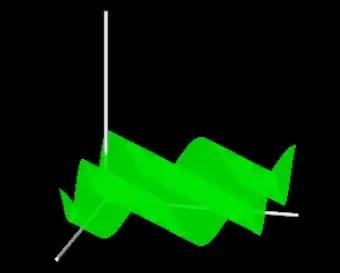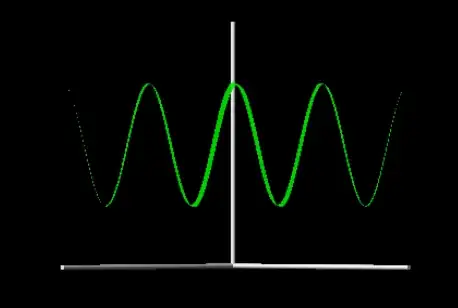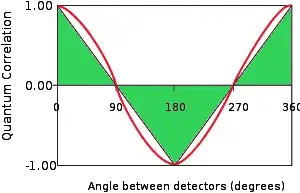J Murray answered a previous question with a proof of Bell's Inequality, and a description of it applying to photon polarization.
I probably misunderstood the application to photons, so I want to get that clearer.
First, I think I misunderstood the description of games where the two grad students try to maximize the correlation. They can't be allowed to communicate, or else the experiment could be done while they're at lunch and both filters are set at zero the whole time. Their own settings have to be uncorrelated, so they can be treated as independent random variables.
So what I should do is, for every combination of filter x angle and filter y angle, integrate over angle $\theta$ for the entangled photons, and graph the result.
Next, what I see is relevant about entangled photons, is that they they must have either the same result from a polarizing filter, or the opposite result. I don't care which. So if one particular entangled photon is 100% certain to get through a particular filter, then its entangled photon is either 100% certain to get through, or 100% certain to be absorbed.
So if a photon has a state $\lambda$ that includes a linear polarization angle $\theta$, then its entangled photon has state $\lambda'$ which includes polarization $\theta$, or $\theta+-\pi$, or $\theta+-\pi/2$.
I will start out with the first case because it's easier for me to think about, but maybe in real examples entangled photons are always opposite.
What if entangled photons encounter a filter that is not at 0 or $\pi/2$ or $\pi$ etc? Say the angle is at $\pi/6$ relative to the photon's polarization. Then we know one entangled photon has probability 3/4 to get through. What about the other one?
If all they have in common is their polarization angle, then the second photon will also have 3/4 chance to get through, and for both it's 9/16. 5/8 for both or neither, 3/8 that one gets through, 1/16 neither gets through,.
But maybe if one gets through then the other one must also. Then their combined probability is 3/4, and the probability that neither gets through is 1/4.
Or it could be anywhere in between. Maybe half of them are destined to get through, and for the other half it's an independent 1/2 chance. So 5/8 both get through, 1/4 one does, and 1/8 neither does.
Starting with the idea that entangled photons have independent chances to get through filters, I graphed the probability that both get through, given x and y.
You can look at the 3D graph if you like. Hold down the right button and move the mouse to rotate it.
The results are the same depending on x-y. It's a cosine wave with minima at 1/8 and maxima at 3/8, average 1/4.
The graph for both absorbed is the same, so their sum has average 1/2 with minima at 1/4 and maxima at 3/4.
This looks similar to the intuitive picture.
They simplified it to make the zeroes at 90 degrees and 270 instead of 45, 135, 225, and 315. Also their maximum is at 1 instead of .75. But their argument that it should be straight lines and not a sine wave would probably apply. Why is it a sine wave?
I looked at Araujo's explanation and found only one possible reason to expect that it shouldn't be.
$$p(ab|xyλ)=p(a|xλ)p(b|yλ)p(λ)$$
But this is not true for light. The closer x and y are, the more highly correlated a and b are. And when $p(a|x)$ and $p(b|y)$ are correlated, we can't expect $p(ab|xy)=p(a|x)p(b|y)$.
The conditions for this explanation of Bell's Theorem are not met by light, regardless whether entangled photons do something peculiar.
So I think the simple picture explanation is wrong. Also Araujo's explanation does not fit classical explanations for light, unless I misunderstand it. A classical description of light does not fit the assumptions which lead to Bell's Inequality. (Though Bell's Inequality could still be true for it.)
Where did I go wrong?



